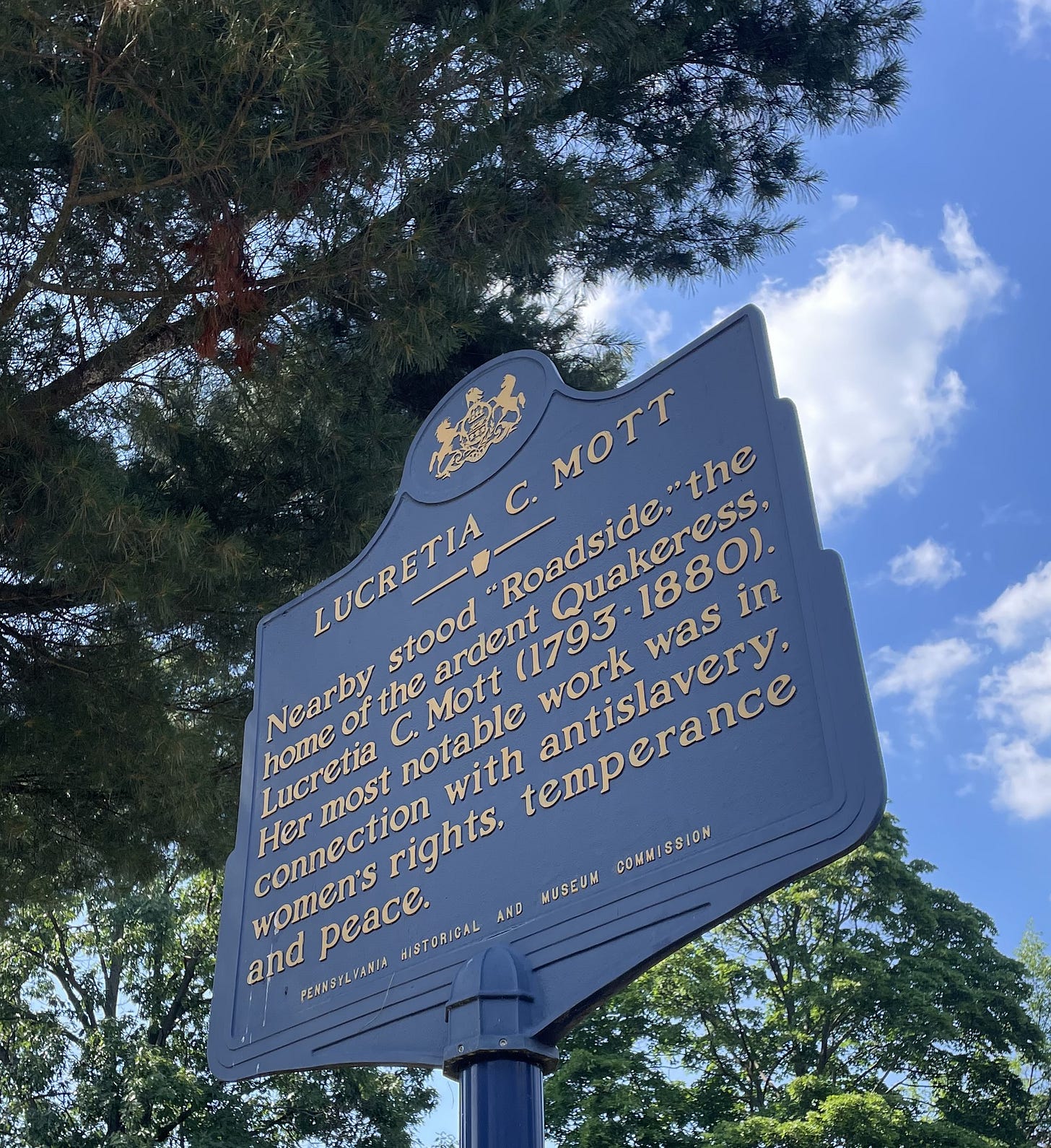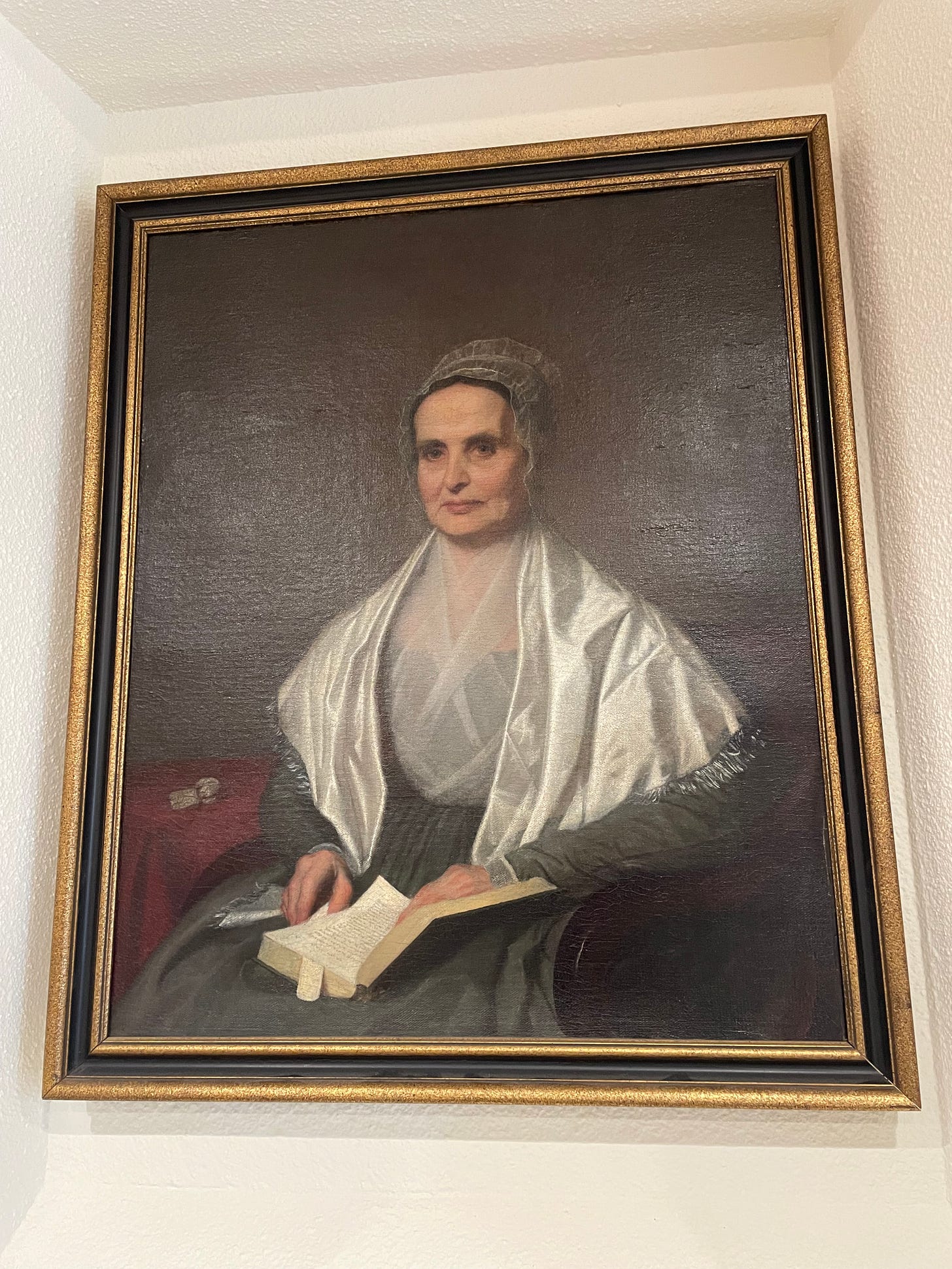Portraying the Legacy of Lucretia Mott
Philadelphia's Union League Gets Its History Wrong - Again
She’s been called “one of the best-kept secrets in American history.” More than 130 years passed after her death before she was the subject of a scholarly biography by an academically trained historian.
Yet Lucretia Mott was without question the most important white female abolitionist in the pre-Civil War period. She was an early and influential proponent of equal rights for women. Her life-long work on social justice issues, her commitment to racial and gender equality, and her opposition to violence in all its forms give her a compelling relevance to our own time.
An Elusive Subject
In a scholarly but eminently readable 2011 biography, Lucretia Mott’s Heresy, Carol Faulkner observed that she remains a “cipher”—one of Mott’s favorite words—largely invisible, as if obscured in a hidden code or puzzle.
Public evidence of Mott is rare: there are precious few public statues of women in Philadelphia, and Mott is not among them. A Pennsylvania Historical Commission marker identifies the former location her home, “Roadside,” but the house itself was demolished long ago.

The neighborhood (close by is “Lucretia Mott Way”) was named “LaMott” in her honor, but that distinction reportedly came about because the first choice, “Camptown,” had already been taken.1
She was depicted in a marble sculpture, along with her younger friends and fellow advocates of women’s rights Elizabeth Cady Stanton and Susan B. Anthony, in the U.S. Capitol in 1921 to commemorate the adoption of the 19th Amendment, which extended the right to vote to women. But that sculpture was soon moved to a basement broom closet, where it remained for the next 75 years.
She was an eloquent and captivating public speaker, yet she wrote (other than her private letters to friends and family) and published almost nothing. But as a woman of national fame, she sat for the painting of several portraits, and for many more photographic images, always with a self-effacing persona—her hair hidden under a simple bonnet and dressed in her typical Quaker clothing—modest, plain, unadorned.

She spent her 18th century childhood on the island of Nantucket, where she was brought up in a Society of Friends (Quaker) community. That religious upbringing imbued in her the belief that there is an “inner light” from God in every human being. Flowing from that was her opposition to slavery as a practice both immoral and inhumane. She also grew up without strict, customary gender roles. Nantucket women took on what were traditionally male responsibilities when the men were absent on lengthy whaling voyages.

She lived almost all her adult life—altogether about 70 years—in Philadelphia or just outside the city in Cheltenham Township, Montgomery County.
Philadelphia was where she married, bore her six children (five would survive to adulthood), worshipped (at the Cherry Street Friends Meeting), and had many of her historically noteworthy speaking engagements—including perhaps her most famous one, delivered in 1849, a transcription of which was later published as “A Discourse on Woman.”2 In 1880, she died at her home in Cheltenham and was buried in North Philadelphia, in the Quaker Fair Hill Burial Ground.
The Union League Portrays Mott
Given our difficulty getting a clear take on Mott, the Union League’s recent unveiling of a newly commissioned oil portrait of her is a celebratory occasion. But consistent with Mott’s elusiveness, the unveiling in late 2022 seems to have gone unreported, perhaps because the Union League was much more in the news then for its controversial award of its Gold Medal—the award that was first given to Abraham Lincoln in 1863—to Florida governor (and former presidential candidate) Ron DeSantis.
The League’s choice of Mott for this honor is bewildering. The portrait, the League explains in its publicity handbill, “serves as a reminder of the important role that women played in the League.”
Perhaps that means after 1986, since the League admitted only men as members for its first 124 years. Mott would not be pleased with that, nor would she have been pleased that the League did not admit any Black men for its first 110 years. After all, she advocated not just for the end of slavery, but for racial equality. The Philadelphia Female Anti-Slavery Society, founded by Mott and others in 1833, was an interracial organization, despite the controversy and violent reactions that their mixed-race meetings provoked.
The League also claims that “Mott worked with the League to establish Camp William Penn, the first training camp for the United States Colored Troops.” But it is unlikely that Mott or the League did anything of the sort. As I’ve written previously, the League shied away from directly recruiting Black soldiers—that was simply too controversial—although the League did recruit for its whites-only regiments. And Mott, with her long-standing pacifism, would not have been one to help set up a military training camp.
I fact-checked this with Professor Faulkner, Mott’s biographer, who agreed, explaining via email that “Mott was a pacifist and opposed to the war on principle.” Faulkner went on to say that “like other Americans, however, she could not help but be connected to the war effort by friends and relatives.” Indeed, Mott’s son-in-law, Edward M. Davis, an ardent abolitionist Quaker, made his personal contribution to the end of slavery by enlisting in the Union Army early in the war. But Mott, writing to her sister in 1861, expressed disapproval of Davis’s joining the army: “He flatters himself that the abolitn. [sic] of slavery – end, justifies means.”3 (Davis’s enlistment also cost him his membership in the Race Street Friends Meeting.) After Davis returned from military service, he leased some of his own land (not the Motts’ land) for the military camp.4
Mott’s View of the Union League
Judging from Mott’s own references to the Union League in her letters, she did not “work with” the League on Camp William Penn—or anything else, for that matter. She expressed thorough-going doubts about the Union League—quite specifically, about its commitment to abolishing slavery.
In a letter to her sister in 1863, less than three months after the founding of the League, Mott reports how she and her good friend, J. Miller McKim, had a lively discussion—“we had it quite spirited, for awhile”—about McKim’s having joined the League. Mott relished such lively discussions and no doubt questioned McKim severely about what he was up to. As Mott explained:
“Miller was defending himself while here for joining the Union League—we being doubtful whether it would be anti-slavery enough to warrant his ‘crying a confederacy.’”5
So she was quite skeptical about McKim’s view that the League would be a part of an anti-slavery “confederacy.” She went on to comment that “Miller thought their League would at least be equal to our Cherry St. Meeting,” referring to the strongly anti-slavery Quaker meeting where Mott worshipped. But Mott also told her sister that McKim was invited to join the League because of “his abolitionism and he thinks there’s an amazing change taking place among the politicians.” This spirited discussion between Mott and McKim took place less than two months after Lincoln’s Emancipation Proclamation, so it evidences how attitudes about slavery were perceived to be changing. And it evidences the existence of an abolitionist element among the League’s members.
More than a year later, Mott attended a meeting where the Union League advocated for support for those recently escaped from slavery. Writing now to another of her sisters, Mott said of this meeting:
“It is ‘as good as a play’ to mingle with the audience in the middle of the hall and let the Freedman’s and Union League committees bear all the burdens—and they may have all the glory too if they will only persevere until every slave is forever free.”6
Her reference to “as good as a play” probably reflects her attitude that the meeting was both entertaining and a bit unreal, while she goes on to emphasize her uncertainty that the League would “persevere” in the abolitionist effort. Indeed, another year and a half had to pass before ratification of the 13th Amendment abolished slavery in the United States. Yet Mott’s questioning of the League’s commitment to ending slavery was not unwarranted: after all, her anti-slavery work preceded the founding of the League not by years, but by decades. And as Mott seemed aware, the abolition of slavery was not one of the League’s stated purposes.
After the Civil War, the Union League sought to glorify and celebrate the Union’s victory. Mott, again, followed a very different path amid the horrific aftermath of the war. In 1866, she was a founder of the Pennsylvania Peace Society, an anti-war organization.
Bringing Mott Portraiture to the Public
Neither of the two local portraits of Lucretia Mott is on full public view. The Union League’s new portrait can be seen only by League members and their guests. An appointment is needed to see the 1850s portrait in the Reading Room of the Friends Historical Library at Swarthmore College. To see Mott painted from life, you’ll need to travel to Washington, where the National Portrait Gallery displays an 1842 portrait by Joseph Kyle.
Let’s hope that the Union League soon displays its portrait publicly—and makes Lucretia Mott less of a best-kept secret in history.
Acknowledgements
I thank the staff of the Friends Historical Library of Swarthmore College for their generous help in making Mott’s original letters available (including a copy of an unpublished letter) quoted herein and for allowing me to photograph and include here the Mott portrait in their Reading Room.
Special thanks to Professor Carol Faulkner for her kind reading and commenting on an earlier draft of this essay.
Special thanks as well to David Lee Preston, who provided excellent editorial assistance and publishing advice on earlier drafts.
David Jenkins Morrison, A Guide Book to Historic LaMott (Cheltenham Township Historical Commission, 1974). Morrison’s account appears to be based on Wallace Triplett, Jr., History of LaMott (1949).
Reprinted in Lucretia Mott Speaks: The Essential Speeches and Sermons (Christopher Densmore et al., eds., Urbana: U. Illinois Press, 2017), p. 68.
Letter of Lucretia Mott to Martha Coffin Wright, August 20, 1861. Mott Manuscripts, Friends Historical Library of Swarthmore College (PSCHi). Quoted in Selected Letters of Lucretia Mott (Beverly Wilson Palmer, ed., Urbana: U. Illinois Press, 2002), p. 316, n. 3.
That the Union League erred in claiming that Mott helped establish a military training camp is quite remarkable. As long ago as 1884, Mott’s attitudes about the war and training of Black troops at Camp William Penn were described in Mott’s granddaughter’s biography of Lucretia and James Mott. “While Lucretia Mott strongly disapproved of war and its attendant barbarities, she nevertheless could not resist the interest that this public acknowledgment of the negro's rights as a soldier called forth. As an abolitionist, she gave the movement her sympathy, but as an advocate of peace, she condemned any resort to carnal weapons. With these conflicting feelings, she seldom visited the camp, and seemed indifferent to its affairs as a military body; but she found many chances to befriend its inmates, both officers and privates, as individuals.” Anna Davis Hallowell, James and Lucretia Mott: Life and Letters (Boston: Houghton, Mifflin & Co., 1884), pp. 406-407.
Letter of Lucretia Mott to Martha Coffin Wright, Feb. 28, 1863. Photostatic copy in the collection of Friends Historical Library of Swarthmore College. Edited transcription in Anna Davis Hallowell, James and Lucretia Mott: Life and Letters, pp. 405-406.
Letter of Lucretia Mott to Martha Mott Lord, April 22, 1864 (A00182036, Mott Manuscripts, SFHL-MSS-035) Friends Historical Library of Swarthmore College.



